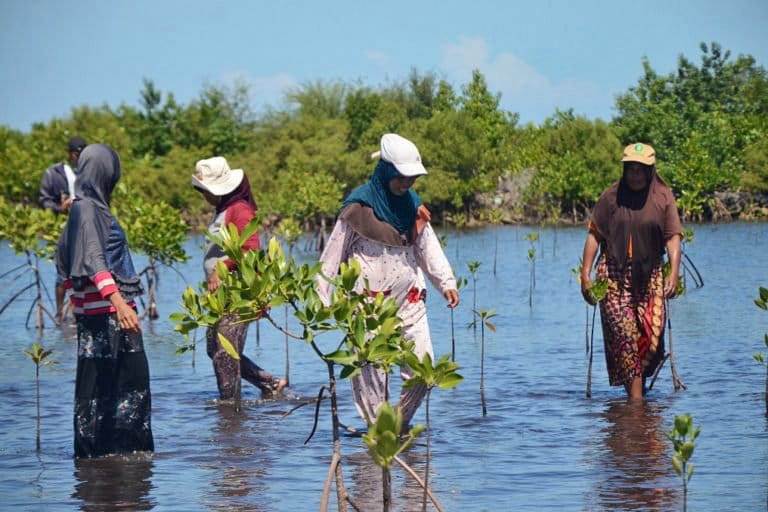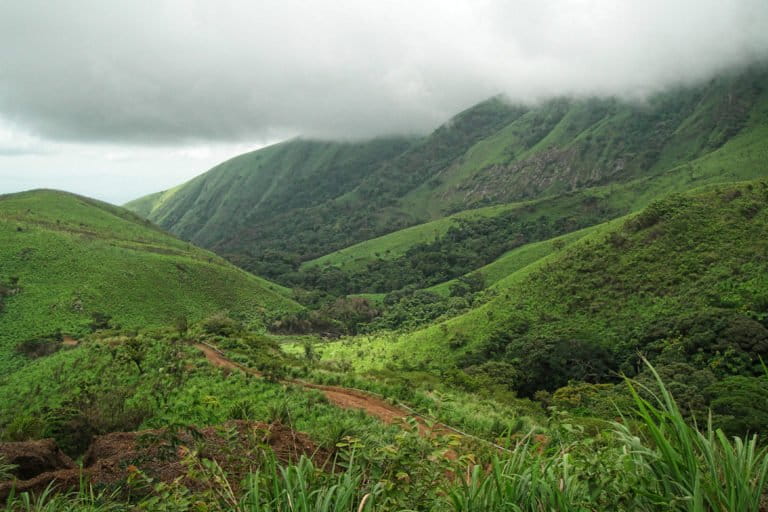- A new form of conservation finance fuses community, wildlife, and nature with the voluntary carbon market, which funnels “global north” money into “global south” projects in exchange for avoided emissions of greenhouse gas emissions.
- “Nature-based solutions” (NbS) could be a successful part of such a market, but only if they are of high quality and are additional to what would have occurred anyway.
- The authors of a new op-ed see enormous potential for NbS carbon credits to help achieve the Paris Agreement goals, support natural ecosystems, and secure the rights and livelihoods of Indigenous peoples and local communities.
- This post is a commentary. The views expressed are those of the authors, not necessarily of Mongabay.
A tropical rainforest spanning the entire Guatemalan Caribbean coastline is among the world’s richest pockets of biodiversity. Historically, it has also experienced some of the highest global deforestation rates, driven mainly by palm oil production and cattle ranching.
But a project known as the Conservation Coast run by a local NGO, Fundaeco is beginning to turn things around. Hailed as the world’s largest grouped forest-based carbon project, it protects more than 62,000 hectares of tropical rainforest and 30 threatened species, supports close to 500 local entrepreneurs, and, to date, prevented over 6 million tonnes of climate-warming CO2 emissions being released in the atmosphere.
On the other side of the globe, the Katingan Mentaya Project in Indonesia protects and restores 157,000 hectares of peat swamp forest. Immense carbon sinks that have developed over thousands of years, peat forests store 5-10 times that stored by carbon mature tropical rainforests. The project benefits 34 village communities, helps stabilize water flows critical for preventing peat fires, and protects some of the world’s most endangered animals. It has also issued an average of 7.5 million triple gold certified carbon credits per year via the voluntary carbon market since 2017.

A continent over in Zambia, the Luangwa Community Forest Project is Africa’s largest REDD+ project generating income and social services to over 217,000 people. It protects over 1 million hectares of forest, or 514 million trees, and is one of the last remaining wildlife strongholds on Earth – home to wild dogs, elephants, and lions. The project contributed to 1.4 million tons of CO2 emission reductions in 2020.
A common thread uniting these projects is a new form of conservation finance that fuses community, wildlife, and nature with the help of the voluntary carbon market, which funnels “global north” money into “global south” projects in exchange for avoided emissions of greenhouse gas emission that are threatening to bring us to the brink of climate catastrophe.
These projects are also examples of how Nature-based Solutions (NbS) for climate are much more than avoided or removed emissions, but also create huge benefits for people and nature.
How can we mobilize the financing necessary to replicate such examples, on a scale necessary, across hundreds of millions of acres of mangroves, forests, savannas, wetlands, seascapes, farms, and cities around the planet, all helping to limit the rise in global temperature to 1.5°C, while benefiting people and nature?
As a groundbreaking study from 2017 suggests, NbS can deliver up to a third of emission avoidance and reduction needed by 2030 to limit global warming to under 1.5°C.
The voluntary carbon market could be a large part of the answer, but only if it operates within guardrails that ensure NbS interventions are of the highest quality and integrity, and that credits generated are issued and used with the integrity needed to accelerate greenhouse gas (GHG) mitigation.

At its core, GHG mitigation resulting from NbS must be additional to what would have occurred anyway, and robustly quantified against a credible, uninflated baseline. Measures will need to be taken to manage the risk of leakage, such as displacement of deforestation activities to another landscape, or reversals due to natural disasters (e.g., if carbon removed by restored vegetation is returned to the atmosphere due to intense wildfires or storm damage). Risk associated with double-counting – when credits are claimed both by the country where they are generated and the purchasing country – must also be managed and avoided.
Examples of robust measures include discounting credits to account for risk, creating buffer pools to compensate for reversals, and ensuring corresponding adjustments are made when credits are traded internationally. These issues will be looked at by the Integrity Council for the Voluntary Carbon Market’s “Core Carbon Principles”, which will drive the integrity and quality of carbon credits within the carbon market so this potential can be realized.
Alongside ensuring that GHG mitigation is real, the carbon market must internalize the role that biodiversity and people play in delivering impactful NbS. The market needs to recognize and value NbS benefits such as:
- Equity and inclusivity – These benefits accrue when NbS activities are co-designed with Indigenous Peoples, local communities, and smallholder farmers, rights are respected, and benefit sharing is exemplary. At a minimum, carbon credits should adhere to safeguards related to rights and due process. NbS will only endure when people benefit.
- Social well-being – NbS can deliver diverse social benefits related to livelihoods, health, poverty alleviation, and sustaining cultural identity. NbS can also contribute to climate change adaptation. For example, mangrove forest restoration will not only contribute to GHG sequestration, but it will also protect against sea surges, reducing vulnerability to climate-related disasters.
- Biodiversity net gains – By definition, NbS are conservation, resource management, or restoration measures that benefit nature. At a minimum, carbon markets should require that NbS result in a net gain to biodiversity and ecosystem integrity.
The carbon market should not only set minimum do-no-harm safeguards but also foster monitoring, verification, and reporting of social and biodiversity benefits, such that buyers can differentiate and give preference to credits with the most core benefits for nature, people, and climate.

But can the carbon market drive investment in NbS at the scale needed to halt global deforestation and habitat loss and restore hundreds of millions of hectares of land, and empower and benefit local communities? This scale of action will require working at a larger landscape level, bringing together all the different stakeholders, and working across a mosaic of land uses.
Success will be driven by scale and systemic transformation, and a jurisdictional approach to carbon crediting for NbS has the potential to deliver on both. Working within jurisdictions of national and sub-national governments, such efforts can include reform and enforcement of laws and policies governing protection and use of natural resources and recognition of the rights of Indigenous Peoples and local communities.
Jurisdictional approaches to crediting would require project-scale activities and their accounting to nest within jurisdictions and be assessed against a common baseline. They can also enable fairer deals with local stakeholders ensuring equitable benefit-sharing and respect of rights-holders such as Indigenous Peoples.
Advance purchase agreements for jurisdictional-scale credits will create the incentives to transition from stand-alone projects to jurisdictional-scale crediting.
In addition to supply-side mechanisms to advance the quality and scale of credits generated by NbS, the carbon market also needs to embrace demand-side guardrails to ensure that the purchase and use of credits enhances, rather than dilutes, climate mitigation goals.
Fundamentally, the market should motivate all companies and institutions to abate their emissions at a pace consistent with limiting global warming to 1.5°C. The market should oblige organizations to pursue a mitigation hierarchy and follow a science-based pathway to net zero emissions in their own value chain. Most organizations will nevertheless have annual unabated emissions on their path to net zero and some residual emissions that can’t be abated. They should be incentivized to purchase carbon credits generated beyond their value chain to counterbalance these annual unabated emissions on their journey to net zero. This bounded approach to use carbon credits will increase, not dilute, their contribution to global climate change mitigation.
How to pick a tree-planting project? Mongabay launches transparency tool to help supporters decide, learn more here

For example, the Natural Climate Solutions Alliance, a multi-stakeholder coalition of businesses, NGOs and solution providers, has created a NCS Investment Accelerator to aggregate corporate demand for 1 gigaton of CO2e of high-quality emission reductions and removals per year by 2025.
Participating corporations must use carbon credits generated by investments in NbS for climate mitigation to go above and beyond internal decarbonization required to meet the Paris Agreement goals.
The recently released Tropical Forest Credit Integrity Guide aims to help companies interested in high-quality tropical forest carbon credits to improve the integrity and impact of these purchases. It is another example of an initiative that brings us closer to a well-functioning and effective voluntary carbon market.
We see enormous potential for increased use of carbon credits generated by NbS to help deliver the Paris Agreement climate goals, foster the protection and restoration of natural ecosystems, and secure the rights and livelihoods of Indigenous Peoples and local communities. We also appreciate the challenge that companies are facing – going beyond value chain mitigation will require additional investments. However, as clearly stated by the recent IPCC report, we are almost at the point of no return, and therefore, we need to do more and faster. Investing in nature-based carbon credits to address the annual unabated emissions can certainly offer an important contribution.
Rod Taylor is Global Forests Director for World Resources Institute, Kavita Prakash-Mani is the former CEO of Mandai Nature, and Giulia Carbone is Director of the Natural Climate Solutions Alliance at World Business Council for Sustainable Development.
Related audio from Mongabay’s podcast: On this episode we look at mangrove restoration and the effectiveness of nature based solutions to climate change, listen here:
Beyond tree planting: When to let forests restore themselves